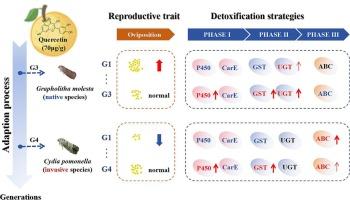Different detoxification strategies of fruit borers adaptation to quercetin
IF 4
1区 农林科学
Q2 BIOCHEMISTRY & MOLECULAR BIOLOGY
引用次数: 0
Abstract
During long-term plant-insect interactions, plants have evolved diverse plant secondary metabolites (PSMs) as defenses against herbivory, while insects have developed sophisticated detoxification mechanisms to neutralize these compounds. Invasive and native herbivorous species may employ distinct metabolic strategies to cope with PSMs, a phenomenon that remains incompletely characterized. Here, we report the differential detoxification strategies of two closely related fruit borers, the invasive Cydia pomonella and the native Grapholita molesta, which exhibit interspecific competition, in response to quercetin stress—a flavonoid present in their host fruits. C. pomonella requires more generations to adapt 70 μg/g quercetin, indicating differential tolerance to flavonoid toxicity. Metabolic profiling shows G. molesta primarily detoxifies quercetin mainly via synergistic cytochrome P450 (P450) and transmembrane transport, whereas C. pomonella shifts from transport to a predominant role of oxidation over time. Given that C. pomonella was not pre-adapted to high quercetin stress in its native habitat, its constitutive defense system was likely suppressed under quercetin exposure. This species compensated by upregulating ATP-binding cassette (ABC) transporter-mediated excretion, as evidenced by HPLC quantification which indicated that the fecal quercetin content exceeded 50 % of the administered dose. Correlation analysis suggests that C. pomonella employs a biphasic detoxification: initial short-term dominated by ABC transporter activity, followed by a long-term reliance on P450-mediated metabolism. Conversely, G.molesta primarily utilizes a synergistic enzymatic detoxification system involving multiple enzymes. These findings elucidate divergent adaptive mechanisms to quercetin stress in the two fruit borers and enhance understanding of herbivorous insect-plant co-evolution and the interspecific interactions between invasive and native pest species.

果螟对槲皮素适应的不同解毒策略
在植物与昆虫的长期相互作用中,植物进化出多种植物次生代谢物(psm)作为对食草动物的防御,而昆虫则发展出复杂的解毒机制来中和这些化合物。入侵和本地草食性物种可能采用不同的代谢策略来应对psm,这一现象仍未完全表征。在这里,我们报道了两种密切相关的果螟,入侵的Cydia pomonella和本地的Grapholita molesta,它们表现出种间竞争,以响应槲皮素胁迫-一种黄酮类化合物存在于它们的宿主果实中。pomonella需要更多代来适应70 μg/g的槲皮素,表明其对黄酮毒性的耐受性存在差异。代谢分析显示,毛孢霉主要通过协同细胞色素P450 (P450)和跨膜转运来解毒槲皮素,而单胞菌则随着时间的推移从转运转变为主要的氧化作用。鉴于pomonella在其原生栖息地没有预先适应高槲皮素应激,其构成防御系统可能在槲皮素暴露下受到抑制。这种物种通过上调atp结合盒(ABC)转运体介导的排泄来补偿,正如HPLC定量所证明的那样,粪便中的槲皮素含量超过了给药剂量的50%。相关分析表明,pomonella采用双期解毒:最初短期以ABC转运蛋白活性为主,随后长期依赖p450介导的代谢。相反,G.molesta主要利用一个涉及多种酶的协同解毒系统。这些发现阐明了两种果螟对槲皮素胁迫的不同适应机制,并加深了对草食虫-植物协同进化以及入侵和本地害虫种间相互作用的认识。
本文章由计算机程序翻译,如有差异,请以英文原文为准。
求助全文
约1分钟内获得全文
求助全文
来源期刊
CiteScore
7.00
自引率
8.50%
发文量
238
审稿时长
4.2 months
期刊介绍:
Pesticide Biochemistry and Physiology publishes original scientific articles pertaining to the mode of action of plant protection agents such as insecticides, fungicides, herbicides, and similar compounds, including nonlethal pest control agents, biosynthesis of pheromones, hormones, and plant resistance agents. Manuscripts may include a biochemical, physiological, or molecular study for an understanding of comparative toxicology or selective toxicity of both target and nontarget organisms. Particular interest will be given to studies on the molecular biology of pest control, toxicology, and pesticide resistance.
Research Areas Emphasized Include the Biochemistry and Physiology of:
• Comparative toxicity
• Mode of action
• Pathophysiology
• Plant growth regulators
• Resistance
• Other effects of pesticides on both parasites and hosts.

 求助内容:
求助内容: 应助结果提醒方式:
应助结果提醒方式:


